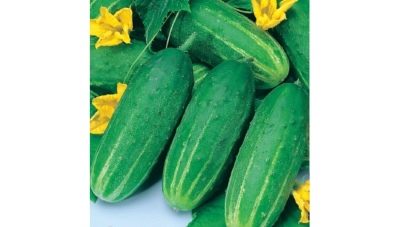
- Year of approval: 1991
- Growth type: indeterminate
- Fruit weight, g: 80-125
- Fruit length, cm: 10,2-11,7
- Fruit color: green, with white longitudinal stripes
- Ripening terms: early
- Pollination: bee-pollinated
- Fruit shape: from elliptical to elongated ovoid
- Fruit taste: 3.9-4.3 points (for fresh fruits), 4.2 points (for canned), 3.6 points (for salted)
- Appointment: for pickling and preserving
When choosing a variety of cucumbers for planting, many summer residents and farmers prefer varieties with a long history, which, with minimal agricultural technology, give consistently high yields. The early maturing variety Reliable of domestic selection belongs to such species.
Breeding history
The Reliable variety is a vegetable crop that has been proven over the years. Scientists of the Federal Research Center of Vegetable Growing bred the variety in 1987. After carrying out variety trials, the cucumber variety was added to the State Register of Breeding Achievements of the Russian Federation in 1991. It is recommended to grow a crop in open ground. The variety is zoned in 9 regions - from Central to Ural and East Siberian.
Description of the variety
The early variety is a medium-sized plant of an indeterminate type, the central stem of which can stretch up to 130 cm. The bush is characterized by strong climbing, weak growth of lateral shoots, moderate thickening of bright green foliage and a developed rhizome.
A distinctive feature of the plant is considered to be a mixed type of flowering - there are an equal number of female and male flowers. During the flowering period, light yellow flowers of a large shape are formed on the bushes. The vegetable crop belongs to the class of bee-pollinated plants.
Characteristics of the appearance of plants and zelents
Variety Reliable - these are medium-sized leveled cucumbers, endowed with good commercial qualities. On average, fruits ripen on the bushes weighing from 80 to 125 grams and a length of 10.2-11.7 cm. The shape of zelents is unusual - elongated-ovoid or elliptical. The ripe vegetable has an attractive color - light green, diluted with indistinct whitish stripes. The peel of the zelents is tender, slightly elastic, covered with large tubercles, small black thorns and noticeable ribs.
Ripe greens tolerate transportation well, and are also able to be stored for a long period without loss of external and taste properties. The ideal temperature for storing cucumbers is + 3 ... 5 degrees.
Purpose and taste of fruits
Cucumbers taste great. Cucumber pulp has a tender, dense, fleshy, juicy and very crunchy texture without voids and wateriness. The vegetable has a balanced taste - sweetish, without bitterness. The aroma is pronounced - refreshing. There are very few seeds inside the pulp. It is noteworthy that the crunch and freshness of zelents are preserved even after heat treatment.
Pickled cucumbers can be eaten fresh, added to salads and various dishes, and they are also good for preservation, pickling and pickling.
Maturation
This variety belongs to the early maturing group. From the moment of mass shoots to the appearance of the first cucumbers on the bushes, 38-44 days pass. Zelens ripen amicably, so it is recommended to choose them regularly - every few days. The harvesting period is extended - from the last week of June to August.
Yield
The variety is declared as productive, and the yield is not affected by temperature and weather factors. For 1 m2 of plantings, you can collect 2.6-4 kg of crispy cucumbers. On an industrial scale, the average yield reaches 254-387 c / ha.
Landing scheme
In order for the plant to grow comfortably, it is necessary to observe the distance and density when planting. It is recommended to plant 3-4 bushes per 1 m2. The correct layout for planting is 30x70 cm.
Growing and care
You can grow a vegetable through seeds and seedlings. It is the seedling method that is more acceptable for many gardeners, since it allows you to enjoy crispy cucumbers in the early stages. Seedlings can be planted in the garden from the end of May to the beginning of June, when the soil and air are well warmed up. Seedling bushes should be strong, 20-25 cm high and with 3-5 true leaves. You should not plant cucumbers in the place where pumpkin crops grew.
Agrotechnics of this variety include: irrigation with settled water (as needed), fertilization, alternating organic matter and mineral complexes (weekly), weeding and loosening of the soil, formation and thinning of bushes, tying to supports, prevention of viruses.
Soil requirements
It is comfortable to grow and develop cucumbers on light, fertile, moisture and air permeable soils. It is important that the soil is low in acidity. In addition, planting in wetlands is not recommended.

In order to collect strong, tasty and beautiful cucumbers on your site, you need to make top dressing. Lack of nutrients can negatively affect the appearance of the plant and significantly reduce the yield. Fertilize cucumbers with organic fertilizers in combination with mineral fertilizers. With the right balance of these components and adherence to the fertilizing schedule, the cucumber yield will be maximum.
Required climatic conditions
Cucumbers Reliable is a thermophilic crop, resistant to sudden temperature fluctuations and short-term shade. The vegetable should be planted in an area well-lit by the sun, but protected from cold winds and drafts. The plant reacts negatively to excess moisture and moisture.
Disease and pest resistance
Due to its early maturity, the culture avoids many diseases. Good immunity protects the plant from the cucumber mosaic virus. The cucumber is susceptible to ordinary and downy mildew. Dangerous insects are: aphids, thrips and whiteflies.

Despite their popularity, cucumbers are often attacked by diseases and pests. From them, cucumber plantings often die before the start of fruiting. In order to prevent this from happening, it is necessary to try to prevent ailments or get rid of them at the very beginning, having studied in detail their causes of occurrence, signs and methods of treatment.





























































































